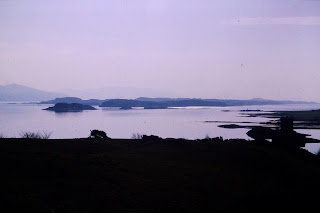I’ve managed to get this far without mentioning the fact about Fish that nearly every article about him starts with, namely ‘former frontman for progressive rock band Marillion' which is indeed the guise in which many (most?) of his fans first encountered his music and his thought-provoking, clever and personal lyric writing. It's somewhat ironic to start there, as his solo career, since leaving Marillion in 1988 has been four to five times as long as his Marillion career and has produced 11 studio albums and 21 (!) live albums. His final album, Weltschmerz, released in 2020, is perhaps as fine a set of songs as he has ever produced, widely acclaimed as a career high, something he has said he wanted to end his career with (although you can have fun debating best and favourite albums with his fans!).
Fish and his wife Simone have sold up their home and recording studio near Haddington (20 miles east of Edinburgh) and moved to the Outer Hebrides, to run a croft on the island of Berneray. In November 2023, he struck a deal with Primary Wave Music, a leading independent publisher of iconic and legendary music who acquired his master royalties and writer’s share for for the songs he wrote and recorded with Marillion. He has wound up his Chocolate Frog record company and his Fish online music and merchandise shop and he is retiring properly. Fish has said all along that he is a writer who can sing (rather than a singer who can write songs) and he means to work on his autobiography, screen plays and… who knows what else? And, after tonight, he will be the artist formerly known as Fish, that identity being put to bed so he can resume his life as Derek.
Fish's solo career has been characterised by a warm and generous relationship with his fans, with 'meet-and-greets' and numerous fan weekends and conventions, often in continental Europe and some in Haddington in East Lothian, Scotland, where Fish has been based for over 30 years. Throughout lockdown, and until recently, Fish also live streamed on Facebook from his home near Haddington almost every Friday evening for two hours from 6pm UK time, engaging in a live interactive session with his fans through their Facebook comments on the live stream. These 'Fish on Friday' sessions, named after his Planet Rock radio show, were hugely popular with fans and Fish has said in interview that it was as much for his own mental well-being during lockdown, as it was for the fans. Nevertheless, it was a great and pretty generous commitment of his time and energy and was much enjoyed and appreciated by many.
Wet Circles' (from their fourth studio album 'Clutching at Straws', in 1987) one of my favourites, with its references to places and people we grew up around.
His solo career kicked off in Autumn 1989 with a single release, State of Mind, and a UK tour ahead of the launch of his first solo album, 'Vigil in a wilderness of mirrors'. I managed to see his two warm-up gigs for that tour, in Haddington's Corn Exchange in October 1989 (my diary entry says his new solo material was 'very strong (and good)' - incisive assessment!). And then... and then... I wouldn't see Fish play live again for another 21 years which, when I look back is a bit shocking. I bought his first four solo albums as they were released (and loved the first two intensely) but then studies, work, relationships, other priorities, life just got in the way. I have listened to and loved his Marillion and solo music all through those years but just never got to gigs (not just Fish gigs either) or fan conventions. In 2006, the aforementioned lifelong gig pal Pete called me and said I had to buy 13th Star, Fish's latest solo album - he was of course correct that I would love it. A real gem full of wonderful songs. And I was inspired to play catch-up with the albums from the intervening years. A cornucopia of music over the period, with Fish's heart worn on his sleeve for all to hear, and a world view in his lyrics that swung at outrage and optimism in equal measure.
I finally managed to see Fish play live again in 2010, again in Haddington, on the acoustic Fishheads Club tour with Foss Paterson on keyboards and Frank Usher on guitar, in the enormous Saint Mary's Church where one of Fish's weddings took place. I'm so glad I went to that show as I made lifelong friends from a conversation over the course of an hour at the head of the queue with a Dutch couple, Tom and Ellen, whose love of Fish's music had brought them (not for the first time) to Scotland just to see his shows. We hit it off, have been friends ever since and have had some great adventures - thanks to Fish and the power of saying hello!
So when 'Weltschmerz' was released in 2020, and a farewell tour mentioned (and eventually, post-COVID, emerged in 2024/2025), I was keen to go for one last hurrah, to see Fish off into his retirement, taking the chance to enjoy him playing live one final time in 'The Company' of Fish's loyal and enthusiastic fans and with Fish's hugely talented and experienced band of friends and long-time collaborators. We had a moving and joyful night at the first show of the tour, in the Haddington Corn Exchange in February 2025, back together with Pete and Simon, with whom I went to many rock gigs in the 1980s. That was meant to be it. A final night of live Fish to close the circle after 43 years.
Fish and Simone on Berneray (c) Fish/ Derek Dick
Photos (c) Scot Mathieson except where stated otherwise






































